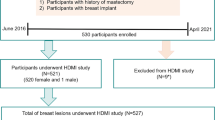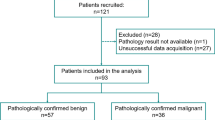Abstract
Background: Tumor growth and metastases require the development of new vessels (angiogenesis). Angiogenesis, assessed by microvessel count using immunocytochemical stain of endothelial cells, has been shown to predict metastases and correlate with early death. Recently developed color Doppler mapping can detect the “tumor flow signals” in breast cancer and help to distinguish it from benign lesions. The question is, does this tumor vascularization assessed by color Doppler mapping correlate with the angiogenesis assessed by immunocytochemistry?
Methods: Eighty-four patients admitted for breast surgery were studied. The final diagnosis was made by pathology for 52 malignancies and 32 benign lesions. The color Doppler mapping of the breast lesion was made preoperatively. The following parameters were assessed: (a) vessel location (peripheral or central); (b) density of color Doppler signals; and (c) maximum systolic velocity. Tumor angiogenesis was assessed by microvessel count under light microscopy using the platelet/endothelial cell adhesion molecule antibodies (CD31) method. The correlation between maximum velocity and microvessel count of breast cancer was examined. The clinical significance of maximum flow velocity of breast cancer with various clinicopathologic factors was assessed.
Results: Color signals were detected in 48 cases of 52 malignancies (92%). All tumors demonstrated signals at the periphery of the lesion but in only 13 (27%) were the signals detected within the tumor. Color signals were scored as + + or + + + in 44 (92%) patients. Pulsed wave blood flow was shown in all these 48 tumors, with maximum velocities varying from 4 to 36 cm/s. Among the 32 benign lesions, color signals were detected in 10 (31%) and all were peripheral and scored subjectively as +. Evaluation of these color Doppler mapping parameters shows no significant correlation with microvessel counts using CD31 monoclonal antibodies. However, there was a positive association (p<0.05) between nodal metastases and higher tumor flow velocity in T1 (<2 cm) breast tumors but not in larger tumors.
Conclusion: Although the color Doppler mapping has been shown to be useful in distinguishing benign from malignant breast lesions, the intensity of signal and velocity of flow had no correlation with the extent of angiogenesis of breast cancer. The presence of high-flow tumor signal in early breast carcinoma is significantly associated with the presence of axillary lymph node metastases.
Similar content being viewed by others
References
Folkman J. What is the evidence that tumours are angiogenesis dependent?J Natl Cancer Inst 1990;82:4–6.
Liotta L, Kleinerman J, Saidel G. Quantitative relationships of intravascular tumor cells, tumor vessels, and pulmonary metastases following tumor implantation.Cancer Res 1974;34:997–1004.
Weidner N, Semple JP, Welch WR, et al. Tumor angiogenesis and metastases — correlation in invasive breast carcinoma.New Engl J Med 1991;324:1–8.
Horak ER, Leek R, Klenk N, et al. Angiogenesis, assessed by platelet/endothelial cell adhesion molecule antibodies, as indicator of node metastases and survival in breast cancer.Lancet 1992;340:1120–4.
Cosgrove DO, Bamber JC, Davey JB, et al. Color Doppler signals from breast tumors.Radiology 1990;176:175–80.
Adler DD, Carson PL, Rubin JM, et al. Doppler ultrasound color flow imaging in the study of breast cancer: preliminary findings.Ultrasound Med Biol 1990;16:553–9.
Gatter K, Falini B, Mason D. The use of monoclonal antibodies in histopathological diagnosis. In: Antony PP, ed.Recent advances in histopathology. Londond: Longmans, 1984:35–67.
Cole-Beuglet C, Soriano RZ, Kurtz AB, et al. Ultrasound analysis of 104 primary breast carcinomas classified according to histopathologic type.Radiology 1983;147:191–6.
Harper AP, Kelly-Fry E, Noe JS, et al. Ultrasound in the valuation of solid breast masses.Radiology 1983;146:731–6.
Jackson VP. The role of US in breast imaging.Radiology 1990;177:305–11.
White DN, Cledgett PR. Breast carcinoma detection by ultrasonic Doppler signals.Ultrasound Med Biol 1978;4:329–35.
Burns PN, Halliwell M, Wells PNT. Ultrasonic Doppler studies of the breast: ultrasonic Doppler studies of the breast.Ultrasound Med Biol 1982;8:127–43.
Schoenberger SG. Breast neoplasm: duplex sonographic imaging as an adjunct to diagnosis.Radiology 1988;168:665–8.
Britton PD, Coulden RA. The use of duplex Doppler ultrasound in the diagnosis of breast cancer.Clin Radiol 1990;42:399–401.
Dock W. Duplex sonography of mammary tumors: a prospective study of 75 patients.J Ultrasound Med 1993;2:79–82.
Shubik P. Vascularization of tumors: a review.J Cancer Res Clin Oncol 1982;103:211–6.
Taylor KJW, Ramos I, Carter D, et al. Correlation of Doppler US tumor signals with neovascular morphology features.Radiology 1988;166:57–62.
Feldman F. Angiography of cancer of the breast.Cancer 1969;23:803–8.
Watt CA, Ackerman LV, Windham JP et al. Breast lesions: differential diagnosis using digital subtraction angiography.Radiology 1986;159:39–42.
Author information
Authors and Affiliations
Rights and permissions
About this article
Cite this article
Lee, WJ., Chu, JS., Houng, SJ. et al. Breast cancer angiogenesis: A quantitative morphologic and doppler imaging study. Annals of Surgical Oncology 2, 246–251 (1995). https://doi.org/10.1007/BF02307031
Issue Date:
DOI: https://doi.org/10.1007/BF02307031




